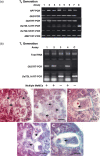OsTDL1A binds to the LRR domain of rice receptor kinase MSP1, and is required to limit sporocyte numbers
- PMID: 18248596
- PMCID: PMC2408674
- DOI: 10.1111/j.1365-313X.2008.03426.x
OsTDL1A binds to the LRR domain of rice receptor kinase MSP1, and is required to limit sporocyte numbers
Abstract
Hybrids lose heterotic yield advantage when multiplied sexually via meiosis. A potential alternative breeding system for hybrids is apospory, where female gametes develop without meiosis. Common among grasses, apospory begins in the nucellus, where aposporous initials (AIs) appear near the sexual megaspore mother cell (MeMC). The cellular origin of AIs is obscure, but one possibility, suggested by the mac1 and msp1 mutants of maize and rice, is that AIs are apomeiotic derivatives of the additional MeMCs that appear when genetic control over sporocyte numbers is relaxed. MULTIPLE SPOROCYTES1 (MSP1) encodes a leucine-rich-repeat receptor kinase, which is orthologous to EXS/EMS1 in Arabidopsis. Like mac1 and msp1, exs/ems1 mutants produce extra sporocytes in the anther instead of a tapetum, causing male sterility. This phenotype is copied in mutants of TAPETUM DETERMINANT1 (TPD1), which encodes a small protein hypothesized to be an extracellular ligand of EXS/EMS1. Here we show that rice contains two TPD1-like genes, OsTDL1A and OsTDL1B. Both are co-expressed with MSP1 in anthers during meiosis, but only OsTDL1A and MSP1 are co-expressed in the ovule. OsTDL1A binds to the leucine-rich-repeat domain of MSP1 in yeast two-hybrid assays and bimolecular fluorescence complementation in onion cells; OsTDL1B lacks this capacity. When driven by the maize Ubiquitin1 promoter, RNA interference against OsTDL1A phenocopies msp1 in the ovule but not in the anther. Thus, RNAi produces multiple MeMCs without causing male sterility. We conclude that OsTDL1A binds MSP1 in order to limit sporocyte numbers. OsTDL1A-RNAi lines may be suitable starting points for achieving synthetic apospory in rice.
Figures






Similar articles
-
Regulatory Role of a Receptor-Like Kinase in Specifying Anther Cell Identity.Plant Physiol. 2016 Jul;171(3):2085-100. doi: 10.1104/pp.16.00016. Epub 2016 May 20. Plant Physiol. 2016. PMID: 27208278 Free PMC article.
-
The MSP1 gene is necessary to restrict the number of cells entering into male and female sporogenesis and to initiate anther wall formation in rice.Plant Cell. 2003 Aug;15(8):1728-39. doi: 10.1105/tpc.012401. Plant Cell. 2003. PMID: 12897248 Free PMC article.
-
Dynamic changes of small RNAs in rice spikelet development reveal specialized reproductive phasiRNA pathways.J Exp Bot. 2016 Nov;67(21):6037-6049. doi: 10.1093/jxb/erw361. Epub 2016 Oct 4. J Exp Bot. 2016. PMID: 27702997 Free PMC article.
-
Ectopic expression of TAPETUM DETERMINANT1 affects ovule development in Arabidopsis.J Exp Bot. 2016 Mar;67(5):1311-26. doi: 10.1093/jxb/erv523. Epub 2015 Dec 17. J Exp Bot. 2016. PMID: 26685185
-
Pre-meiotic anther development.Curr Top Dev Biol. 2019;131:239-256. doi: 10.1016/bs.ctdb.2018.11.001. Epub 2018 Nov 30. Curr Top Dev Biol. 2019. PMID: 30612619 Review.
Cited by
-
BOTRYOID POLLEN 1 regulates ROS-triggered PCD and pollen wall development by controlling UDP-sugar homeostasis in rice.Plant Cell. 2023 Sep 1;35(9):3522-3543. doi: 10.1093/plcell/koad181. Plant Cell. 2023. PMID: 37352123 Free PMC article.
-
Anther and pollen development: A conserved developmental pathway.J Integr Plant Biol. 2015 Nov;57(11):876-91. doi: 10.1111/jipb.12425. Epub 2015 Oct 22. J Integr Plant Biol. 2015. PMID: 26310290 Free PMC article. Review.
-
Regulation of cell divisions and differentiation by MALE STERILITY32 is required for anther development in maize.Plant J. 2013 Nov;76(4):592-602. doi: 10.1111/tpj.12318. Epub 2013 Oct 5. Plant J. 2013. PMID: 24033746 Free PMC article.
-
The role of receptor-like kinases in regulating plant male reproduction.Plant Reprod. 2018 Mar;31(1):77-87. doi: 10.1007/s00497-018-0332-7. Epub 2018 Mar 5. Plant Reprod. 2018. PMID: 29508076 Review.
-
3D cellular morphometrics of ovule primordium development in Zea mays reveal differential division and growth dynamics specifying megaspore mother cell singleness.Front Plant Sci. 2023 May 12;14:1174171. doi: 10.3389/fpls.2023.1174171. eCollection 2023. Front Plant Sci. 2023. PMID: 37251753 Free PMC article.
References
-
- Bi XZ, de Palma J, Oane R, Khush GS, Bennett J. Molecular approaches to fixing the heterozygosity of hybrid rice. In: Virmani SS, Mau CX, Hardy B, editors. Hybrid Rice for Food Security, Poverty Alleviations, and Environmental Protection. Proceedings of the 4th International Symposium on Hybrid Rice. Los Baños, Philippines: International Rice Research Institute; 2003. pp. 135–150. Hanoi, Vietnam, 14–17 May 2002.
-
- Bracha-Drori K, Shichrur K, Katz A, Oliva M, Angelovici R, Yalovsky S, Ohad N. Detection of protein–protein interactions in plants using bimolecular fluorescence complementation. Plant J. 2004;40:419–427. - PubMed
-
- Brar DS, Elloran RM, Lanuang MC, Tolentino VS, Khush GS. Screening wild species of rice for apomixis. Philipp. J. Crop Sci. 1995;20:6.
-
- Canales C, Bhatt AM, Scott R, Dickinson H. EXS, a putative LRR receptor kinase, regulates male germline cell number and tapetal identity and promotes seed development in Arabidopsis. Curr. Biol. 2002;12:1718–1727. - PubMed
Publication types
MeSH terms
Substances
LinkOut - more resources
Full Text Sources
Molecular Biology Databases
Miscellaneous

